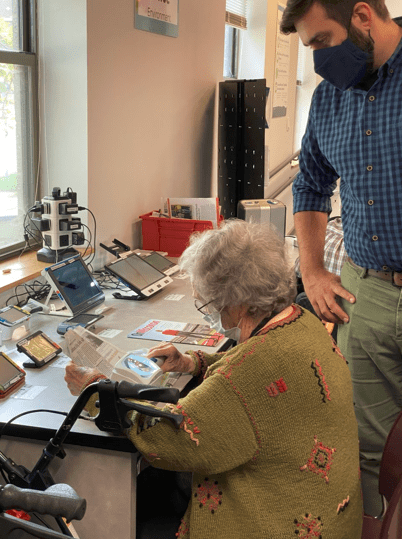
Someone once said, “The internet may give you what you want, but it won’t give you what you need.” Whether it’s surfing for accurate product reviews day or purchasing a pair of shoes that fit properly from Amazon, internet shopping can be a true “buyer beware” endeavor.
There’s no substitute for an actual storefront staffed with knowledgeable people. The Council’s Sharper Vision Store has the staff and the inventory to help you make informed choices and smart buys.
Greg Schmidt is the Sharper Vision Store Customer Care Specialist. He knows firsthand the advantages of a store visit over an internet search. “Shopping with us, you have that one-on-one experience of testing products to see if they work,” he says. “Online, you’re not quite sure what you’re getting.” Greg uses magnifiers as an example. Often a buyer who uses some random internet store will receive a different magnification level than what they ordered. And even if they receive what they ordered, not having the ability to try it out first may lead to sending it back.
“You might luck out and find something appropriate,” Greg concedes, “but here you can try different items to find something that works best, and you have someone who’s knowledgeable standing right there to answer your questions or point you to another option on the shelf that might fit your needs better.”
Those in-store options are another key advantage to shopping at the Sharper Vision Store as opposed to, say, a big chain drugstore. They may only keep two kinds of magnifiers in stock. The Sharper Vision Store carries many different models.
Sharper Vision Store shopping also provides advantages to people who are buying products for others. Often a family member, with the best intentions, will pop on Amazon and buy a product for a family member or friend with a visual impairment. “But the potential for aggravation or a drawer filled with unused items is pretty high,” says Amy Wurf, Education and Vision Services Director at the Council. “I can’t tell you how many things we see unused in people’s houses. Family members mean well, but it’s often not helpful.” Amy frequently hears comments like “My grandchildren gave me this and I don’t have the heart to tell them that it’s not right for me.”
In addition to being an opportunity to make an informed purchase, Greg sees coming into the Sharper Vision Store as a gateway to the services the Council offers in conjunction with the products. Vision service professionals are right there in the building and can even schedule home visits to make sure a customer is getting what they expect and need from the items they buy. Greg says listening carefully to a customer is a large part of his job.
“You pick up cues from somebody struggling with a product,” Greg says. “Those cues may tell me that the customer may need more training to use the product effectively.” For example, when a customer reveals that they’re having trouble with their work on a computer, Greg can offer to coordinate a visit with the Council’s Access Technology Specialist, Jim Denham. Or he can refer somebody who is using a white cane for the first time to Certified Orientation and Mobility Specialist Brent Perzentka for training. Amy, a Certified Low Vision Therapist, can provide a functional low vision evaluation to help them understand how to make the best use of lighting and magnification products.
Greg notes that working with first-time shoppers can be especially gratifying. He says he greets them with a series of questions in his head. “Where are they at? What needs do they have? What is becoming more difficult for them?” he says. A first-time customer may be in the middle of a challenging emotional transition. “Emotional terrain can range anywhere from depression to confusion to anger,” Greg says. “That’s where reading the room as to where they’re coming from emotionally is so important. As an individual who runs the store, my main goal is to build trust, not to draw a higher profit margin. Instead of trying to maximize revenue, we’re focused on an accurate and honest assessment of what the customer’s needs are. At the end of the day, we’re here to help, not sell you a product.”

